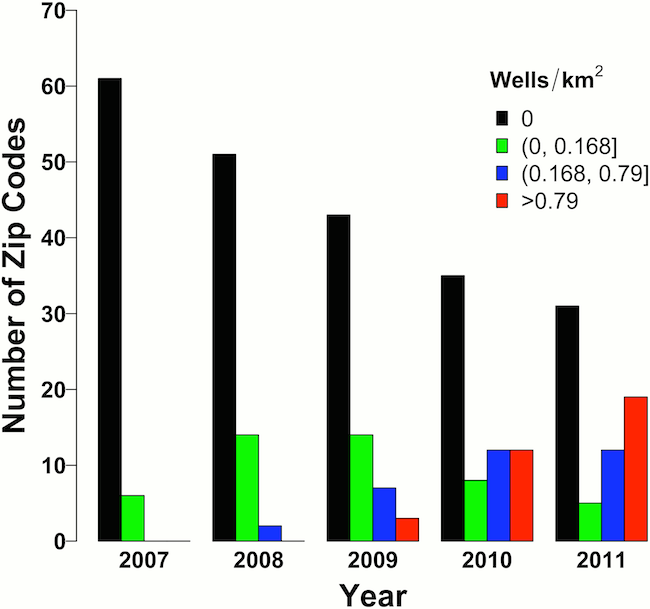
Fleet owners in the U.S. have been turning to compressed natural gas as a "clean" alternative to diesel and gasoline, but a new study of natural gas fracking in Pennsylvania suggests that there are deep holes in the strategy.
The new study, from the University of Pennsylvania and Columbia University, links a significant increase in hospitalizations to a "meteoric" increase in the number and density of natural gas wells in two Pennsylvania counties.
The new natural gas fracking study
Fracking refers to a formerly unconventional gas and oil drilling method [UGOD] that involves pumping vast quantities of chemical brine deep underground. Fracking -- short for hydrofracturing -- was practiced for many years in the U.S. without attracting any scrutiny, primarily because it was confined mainly to thinly populated areas in the West. Now that frackable formations in the more heavily populated Midwest and Northeast states are being exploited, significant problems are beginning to emerge.The latest fracking study looked at three northeastern Pennsylvania counties with comparable demographics. Bradford and Susquehanna counties experienced an increase in fracking activity during the study period, from 2007 to 2011. The third, Wayne County, had no new wells during the study period and was used as a control model.
The study looked at 198,000 hospitalizations by zip code, from 2007 to 2011. The in-patient stays were categorized by cost, and the top 25 categories were selected for analysis.
The findings (break added):
" ... revealed that cardiology and neurologic inpatient prevalence rates (the proportion of a population found to have been hospitalized per 100 residents per year) were significantly higher in areas closer to active wells, as determined by the proximity of wells to a person’s home and their density as defined by the number of active wells per square kilometer."In addition, increased neurologic inpatient prevalence rates were associated with higher well density. Hospitalizations for skin conditions, cancer, and urologic problems were also associated with the proximity of dwellings to active wells."
While cautioning that a causal connection is yet to be determined, the researchers are particularly struck by how quickly the correlation between fracking and hospitalizations emerged:
" ... While the clinical significance of the association remains to be shown, UGOD has just begun in Pennsylvania, and thus observing a significant association over this short time is remarkable."
To be clear, a direct causal link between fracking and health impacts is difficult to pin down, primarily because of wide information gaps enabled by a Bush-era regulatory loophole. However, the study does indicate that the economic benefits of fracking activity should be weighed against the potential for significant public health consequences, including an increase in health care costs:
"Our study also supports the concept that health care utilization should be factored into the value (costs and benefits) of hydraulic fracturing over time."
Still not the last straw for fracking
Earlier this month, TriplePundit reviewed three other new natural gas fracking studies that revealed significant water resource issues, public health and community character impacts, and negative effects on other economic sectors, namely agriculture.
This fourth study is certainly not the last straw for natural gas fracking, but scores of local communities have already banned the practice, and just this summer, New York state and Maryland transitioned from moratorium to permanent ban.
In that regard, it is notable that the third county in the Pennsylvania study, Wayne, had no new wells during the study period because of a moratorium imposed by the Delaware River Basin Commission, due to potential impacts on the Delaware watershed.
The legislative response indicates that awareness of the potential for negative impacts is growing, and the increase in hospital visits indicates that part of this trend is linked to direct exposure rather than a general environmental concern or hearsay.
In that context, it is notable that the new fracking study covered only in-patient hospital stays. If there is also a corresponding increase in visits to doctors' offices, walk-in clinics and urgent care facilities, the level of concern related to direct exposure will increase accordingly.
The road to a truly green fleet
That brings the conversation back around to green fleets. Compressed natural gas (CNG) is becoming a fuel of choice for converting fleets to cleaner fuels, particularly when it comes to diesel.
However, with evidence of negative impacts mounting, fleet managers are best advised to explore alternatives including electric vehicles, biogas, liquid biofuel or fuel cells powered by renewable biogas.
Image credit: Via PLOS ONE, creative commons license.

Tina writes frequently for TriplePundit and other websites, with a focus on military, government and corporate sustainability, clean tech research and emerging energy technologies. She is a former Deputy Director of Public Affairs of the New York City Department of Environmental Protection, and author of books and articles on recycling and other conservation themes.














